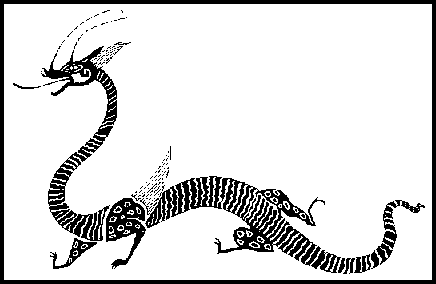Top Ten of
The Season
- The Woman of Rome, by Alberto Moravia (Steerforth Italia). A re-issue of the 1949 novel of the life in the streets of Rome. As in Memoirs of a Geisha one wonders how a man can penetrate, and penetrate so deeply, the heart of woman; and how he can measure out the story so that one never wants it to stop.
- The Age of Extremes: A History of the World, 1914 - 1991, by Eric Hobsbawm (Vintage). Hobsbawm has a clear view of recent history --- so clear that he, like Barbara Tuchman, can make it all like a wonderful, intricate Tolstoi novel. His thoughts on the Russian Revolution and Stalinism are especially rich and meaningful.
- The Social Origins of Islam: Mind, Economy, Discourse, by Mohammed A. Bamyer (University of Minnesota). It all came out of the desert --- the "Empty Quarter." (Bamyeh calls it the "Ideology of the Horizons.") In his hands what is scary and illogical about Islam becomes --- if not reasonable --- at least understandable.
- Of Giants: Sex, Monsters, and The Middle Ages, Jeffrey Jerome Cohen. (University of Minnesota). Any academic who can write a book about medieval monsters, and, in the process, bring in the Jolly Green Giant, The Amazing Colossal Man, the Lincoln Memorial, The Texas Chainsaw Massacres, and King Kong --- while making Beowulf and The Canterbury Tales accessible --- has our undying love and devotion.
- Nobody's Son: Notes from an American Life, by Luis Alberto Urrea. (University of Arizona). Urrea's writing is a combination of the best of Bukowski, Saroyan, Henry Miller, Rabelais, and The Beats; e.g., its funny, sad, wistful, mean, and on occasion, highly artful.
- Mr. Dimock Explores The Mysteries Of the East: Journeys in India, by Edward Cameron Dimock (Algonquin Books of Chapel Hill). Our reviewer said, "When I get through writing this review, I'm going to get in touch with Edward Cameron Dimock, tell him what a dandy writer he is, and mention that next year, if he is planning another journey to Calcutta, I might have some time off to go along with him."
- Faking It: U. S. Hegemony In a "Post-Phallic" Era, by Cynthia Weber (University of Minnesota) The U. S. foreign policy in the Caribbean is here peppered with a touch of Jacques Lacan, and a most garish --- and fascinating --- sexuality. You'll never believe what she makes of Castro and the lust of war.
- When I Was A German: An English Woman Living in Nazi Germany by Christabel Bielenberg (Bison --- University of Nebraska) Bielenberg stayed in Germany until 1945, and her tale is that of a foreigner, trying to make sense of people enmeshed in a national political and social madness. It's her very logical, very English, sometimes dry, humorous way of presenting it that makes this so gripping.
- Phèdre by Jean Racine. Translated by Ted Hughes. (Farrar Straus Giroux).
It's very easy to poo-poo the late Ted Hughes --- his comet still seems a bit too
bright at this moment --- but he does a bang-up good job of
getting us into the heads of these characters, making out of them people we can recognize. As us.
- The Ogre, by Michel Tournier. Translated by Barbara Bray (Johns Hopkins). Says our reviewer, "We become experts on such unlikely subjects as homing pigeons, the antlers of stags, animal scat, Prussian mythology, the origin of the concept of phoric (to bear), St. Christopher, twins, Abel and Cain, and, finally, Nazism and the Hitler Youth.." Critics have compared it to The Tin Drum, he concludes, "but that book of monsters was flat and myopic compared to the rich symphony of The Ogre."
Blues
Bill Traylor
1854 - 1949
Josef Helfenstein and
Roman Kurzmeyer,
Editors
(Yale University Press)
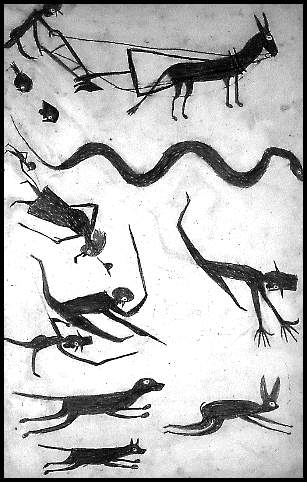
According to those who knew him, he had never drawn before, had never taken lessons, apparently know nothing about "art" (and probably didn't think of what he was doing as "art") --- but there he was --- at age eighty-six, working like a madman. In the few years he was active, he made somewhere between 1,200 and 1,500 drawings of animals, people, the street-life, houses with animals and animals with houses and people all around them. There were snakes, chickens, bears, blue-eyed lizards, birds (red), cats (blue), dogs (yellow), rabbits (blue), turtles (red). There were pitchers and bowls and what now we would call "abstract" designs. There were men with walking-sticks, men with one leg, men kicking, men smoking. men drinking and smoking men working, red, blue, and yellow men. You might call him a street-corner Matisse.
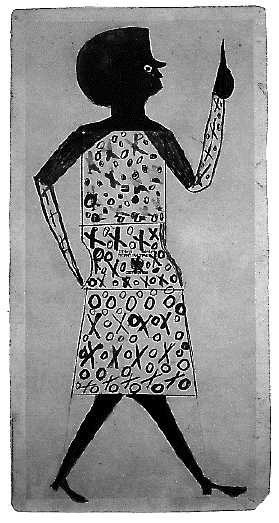 He started out drawing on pieces of cardboard, and as Roman Kurzmeyer points out, when there were imperfections or printed numbers or rips in his "canvas" which he would incorporate into the drawings. A local artist by the name of Charles Shannon began to bring him paints and brushes. According to one observer, Traylor did not acknowledge him (and probably didn't know or care that this bothersome white man was also an artist). Shannon arranged for a showing of Traylor's works at his gallery in Montgomery, the New South, but they sold nothing, and it wasn't until an exhibit at the Corcoran Gallery in Washington some thirty years after Traylor's death that the art world was given a chance to see his drawings.
He started out drawing on pieces of cardboard, and as Roman Kurzmeyer points out, when there were imperfections or printed numbers or rips in his "canvas" which he would incorporate into the drawings. A local artist by the name of Charles Shannon began to bring him paints and brushes. According to one observer, Traylor did not acknowledge him (and probably didn't know or care that this bothersome white man was also an artist). Shannon arranged for a showing of Traylor's works at his gallery in Montgomery, the New South, but they sold nothing, and it wasn't until an exhibit at the Corcoran Gallery in Washington some thirty years after Traylor's death that the art world was given a chance to see his drawings.
This volume, put out to accompany a showing of Traylor's works at the University of Vermont includes almost sixty of his drawings, with photographs from late 30s early 40s of the downtown area of Montgomery associated with the painter. There are also some essays dealing with Traylor's world, his works, a background on southern United States race relations at the time, and an essay on him and the photographs.
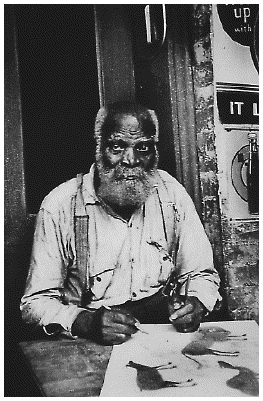 The paintings presented here are wonderful --- colorful, sprightly, imaginative, filled with life. The photographs, too, give an excellent feel for these times in the south, the very poor south --- before WWII arrived and revolutionized the world so. Most of the writings, unfortunately, are what one might call Essays in Stretch --- eg, when there is little to say, fabricate something, anything. For instance, the history of Bill Traylor is no history, outside of what little we know from Shannon and from the public record. Kurtzmeyer tries to compare Traylor with an obscure artist out of the Congo by the name of Djilatendo, while it would have been much easier to show how the flat and playful creatures that Traylor limns are not unlike the cave paintings in the caves of Lascaux, France.
The paintings presented here are wonderful --- colorful, sprightly, imaginative, filled with life. The photographs, too, give an excellent feel for these times in the south, the very poor south --- before WWII arrived and revolutionized the world so. Most of the writings, unfortunately, are what one might call Essays in Stretch --- eg, when there is little to say, fabricate something, anything. For instance, the history of Bill Traylor is no history, outside of what little we know from Shannon and from the public record. Kurtzmeyer tries to compare Traylor with an obscure artist out of the Congo by the name of Djilatendo, while it would have been much easier to show how the flat and playful creatures that Traylor limns are not unlike the cave paintings in the caves of Lascaux, France.
The silliest piece of all is by one Phil Patton, who starts out with The Ultimate Stretch: comparing Traylor to Titian and Van Gogh --- even Winslow Homer. Not content with that, Patton says that Traylor was the visual counterpoint to Hank Williams and the great blues singers like "Big Boy" Crudup, Bessie Smith, and Robert Johnson.
The truth is, you don't have to compare him to anyone but himself. Forget the words. In this volume, the pix are where it's at.
Cold Mountain
Dharma Talks on
Zen Meditation
Reb Anderson
(Rodmell Press)
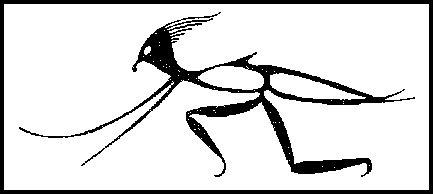 This Zen Buddhism is worse than a needle in the eye. They tell you that all of life is pain, and the way out of this pain is by sitting in pain with your legs crossed for an hour or so a day. As you do this, you are not to think, but if you blow it and do think, you are to merely "watch" your thoughts.
This Zen Buddhism is worse than a needle in the eye. They tell you that all of life is pain, and the way out of this pain is by sitting in pain with your legs crossed for an hour or so a day. As you do this, you are not to think, but if you blow it and do think, you are to merely "watch" your thoughts. On special occasions, you are invited to join with other crazies in a mass sitting for ten or twelve (or fifteen) hours a day, for a couple of weeks. In the meantime, no Big Macs, no fries, no vanilla milkshakes, no frosty Coronas, no after-dinner Cointreau, no stupefying the mind with television, no hanky-panky between the sheets. Making paper birds or building rock gardens not only permitted but encouraged.
The reward: if you manage to shut up the babbling mind, and if you manage to suffer long enough in the lotus position --- you "get it," and you are permitted to come back to earth again, albeit in a "higher" form. When, after six or eight hundred thousand lifetimes, you finally reach the ultimate nothing state, you can tell them to hell with it, tell them you'd rather not go back on the merry-go-round of life ever again. Unless, of course, you decide to forego the eternal of pleasureless pleasure until all sentient beings have reached the same level that you have, maybe in another six million lifetimes.
After all this, if you've decided that Zen is the one for you, then Warm Smiles from Cold Mountains is probably your book. Eighteen different "darma talks" by one Reb Anderson given at various Zen retreats. You may have trouble, as I did, with following the thoughts:
But when human beings accept a precept after hearing that this precept is not about past and future, then they have willingly accepted something that they do not understand.
Or:
At the third level, this precept is not talking about killing and not killing. This precept is pointing out that either of those ways of looking at things is violating Buddha's mind. Thinking that you can kill is violating this precept. Thinking you can keep this precept in a conventional sense is also violating this precept. If you are afraid of being killed, it's because you think that you can kill someone. People who believe that they can kill need some way to stop themselves from acting on their belief...But to think of killing and to realize that it's not possible: that's not to think of killing.
I know, I know --- all these words form an extended koan, something paradoxically paradoxical to force us to reality, T. S. Eliot for the Zen masses; psychological double-talk like that of R. D. Laing, Milton Erickson, Gregory Bateson: to make us sit up and think. Except, in fact, as with all of them --- the purpose is to make us sit up and not think.
Some initiates may not like the messages offered here, flying in the face of what we think of as freedom, such as,
Everything you do in the world as an independent agent is going to cause problems for yourself and others.
On the other hand, Anderson's lessons on, say, suffering, are a perfect example of what we create by believing that we are free and independent, an island:
I feel bad about my suffering. I feel trapped by my suffering, and I feel entangled in my suffering, because I think that I can do something by myself. But when I no longer fall for that and I'm just suffering, then I realize that everybody is helping me, because I couldn't do this suffering by myself. When you realize that everybody is helping you suffer, that is the end of suffering. The expression of suffering doesn't necessarily go away, but you are liberated: you get the joke.
